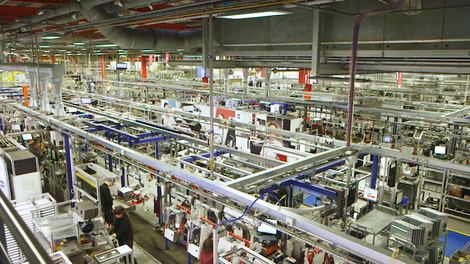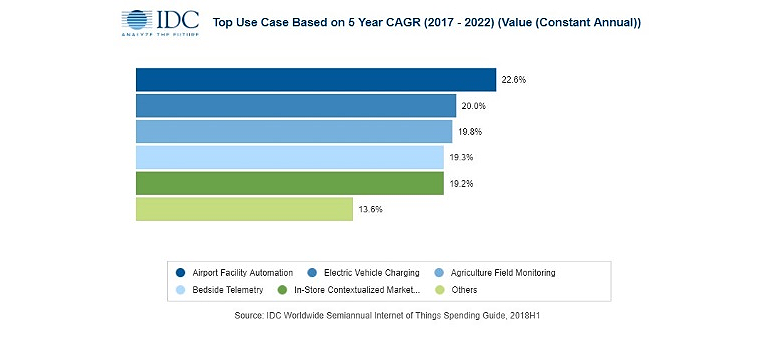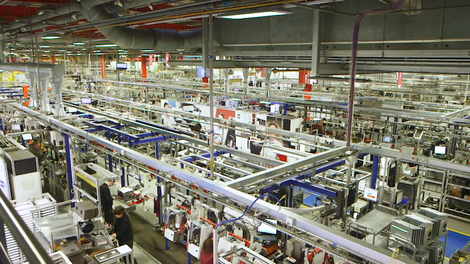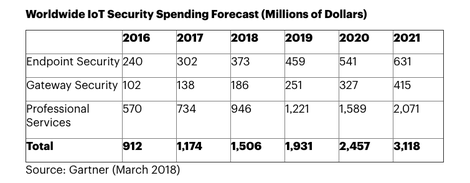

Understanding the Industrial Internet of Things in one article (1) - What is IIoT? What do you need to know about the Industrial Internet of Things
Sensors, Big Data, and Real-Time Decisions: The Industrial Internet of Things Explained.
What is the Industrial Internet of Things (IIoT)?
The Industrial Internet of Things (IIoT for short) refers to those hundreds of millions of industrial devices – from factory machines to aircraft internal engines. These industrial devices have built-in various sensors and are connected to wireless networks for data exchange. Collect and share. The advent of tiny low-cost sensors and high-bandwidth wireless networks means that even the smallest devices can be connected. It usually only takes a certain level of digital intelligence to monitor and track them, share their status data, and in turn communicate with other devices. Staff can then collect and analyze all this data to improve the efficiency of business processes.
What business needs can IIoT solve? Why is IIoT so important?
The IIoT is important because of its potential to make the decision-making process faster and better. The changes that IIoT can bring are also closely related to the digital transformation projects that many enterprises are undertaking.
By providing extremely detailed real-time data, IIoT can help companies better understand business processes, improve process efficiency, and even open up new revenue streams by analyzing data from sensors. IIoT can also give them insight into the wider supply chain, which will allow businesses to coordinate and further improve efficiency.
Which industries are applying IoT?
Currently, the IIoT is receiving particular attention from the manufacturing, retail, utilities and transportation industries. IIoT projects can give manufacturers a better understanding of how their production lines are functioning and better predict when specific machines will need servicing, reducing unplanned downtime. Utilities can use IIoT to allow remote installations to monitor themselves, reducing the cost of sending out staff to inspect remote installations. Retailers can understand where bottlenecks are in their supply chains, and shipping companies can better understand the performance of their fleets. But those aren't the only areas: healthcare and government are also likely to be big adopters of the IIoT. While it's currently being developed primarily by large organizations, it's likely to become more widely adopted as hardware and services become less expensive.
What is the difference between IoT and Industrial IoT?
IIoT should not be confused with consumer IoT, although there is often some overlap between the two. Consumer IoT devices range from smart watches to smart home speakers (as well as light bulbs, door locks, and other smart home devices), and even shoes or clothing. However, the core idea of consumer IoT is fundamentally the same as that of IoT: both use sensors and automation to make processes more efficient. But consumer IoT is not an industrial process, it's about making life easier and more fun (or getting us all caught up in a ubiquitous surveillance network of smart machines, depending on how you look at it).
How big is the Industrial Internet of Things?
Global Internet of Things (IoT) spending is expected to reach $745 billion in 2019, up from $646 billion in 2018, and could reach $1 trillion in 2022. The vast majority of these expenditures will be borne by businesses.
The IIoT is already big business: Manufacturers will spend $197 billion on it this year, transportation companies $71 billion and utilities $61 billion, according to technology analyst IDC. In contrast, consumer IoT spending will reach $108 billion, mostly in smart home, personal health and connected car infotainment.
Companies will also vary in their IoT budget priorities: for manufacturers, systems to support production and asset management will be key; for transportation companies, the priorities will be freight monitoring and fleet management, while utilities will spend Focus on building smart grids, natural gas and water.

IDC says leading IoT businesses will include business use cases in manufacturing ($100 billion), production asset management ($44.2 billion) and freight monitoring ($41.7 billion), but tech analysts say the fastest-growing areas could include airport facility automation , electric vehicle charging, monitoring in the agricultural sector, plus healthcare and in-store marketing retail.
Broken down by technology type, IoT services will account for $258 billion of this, followed by hardware spending at $250 billion — more than $200 billion of which will go to sensors, IDC said. IoT software spending will total $154 billion in 2019. The United States and China will spend the most, followed by Japan, Germany, South Korea, France and the United Kingdom.
What are the current and future Industrial IoT use cases?
Rolls-Royce is a great example of current and future use cases of the IIoT. Engine manufacturers receive more than 70 trillion data points from the engines that serve their customers. While the original service model was for repairing broken engines, it can now use this data to manage and schedule engine repairs, for example by combining this data with machine learning analysis to alert engineers to potential problems before they become aware of them.
The company also has some futuristic ideas, such as using tiny robots just 10 millimeters in diameter and having them crawl through the engine carrying tiny cameras, so engineers can perform visual inspections of the engine without having to remove it from the plane. Another idea is to have remote-controlled robots perform professional repairs, which would reduce the need for engineering teams to travel to where the aircraft is, allowing it to return to service more quickly.
What is the Industrial Internet of Things for today?
The idea of using sensors to track goods or monitor machinery isn't particularly new in itself. What’s different about IIoT is that mass adoption of the Industrial Internet of Things has become possible thanks to affordable sensors, ubiquitous wireless networking options, and the advent of big data analytics.
But for most companies, the IIoT is still in a relatively early stage. Some of these technologies have been (and still are) too expensive or complex for mass adoption, while others — such as 5G networks — are not ready yet.
Which businesses are already benefiting from IoT?
As a result, many potential users of the IIoT are still in the early stages of investment, although large enterprises have made some progress.
In the UK, for example, the government-backed innovation of the Human Digital Catapult is being developed by two manufacturers, Dyer Engineering and Special Metals Wiggin. The program aims to build connected factory demos and seek out IoT and LPWAN-enabled startups that will enable them to deploy their own asset tracking solutions in real-time manufacturing environments. The project aims to help solve some of the challenges associated with process measurement, optimization and control, and the location tracking of indoor assets, equipment and components.
Another set of smart factory trials in the UK will see engineering firm Worcester Bosch use 5G, IoT sensors and data analytics to predict equipment failures to aid in preventive maintenance.

Where is the confusion in the Industrial Internet of Things?
Alternative labels for IIoT are few. Machine-to-machine (M2M) is one of them; there is also talk of a “fourth industrial revolution” or Industry 4.0. All of these labels are largely interchangeable; the key concept is that ubiquitous real-time data and dynamic decision-making can both dramatically improve business performance.
What are the keys to Industrial Internet of Things technology?
The easiest to think of are the three main IIoT infrastructure components: sensors, networking, and data analytics. The IIoT is taking shape because these elements are now mature and inexpensive enough that projects are financially viable. How this is combined will depend on the particular project.
Industrial Internet of Things and 5G
Depending on the project, the sensor can be anything from a video camera to a thermometer or motion sensor. Depending on the use case, networks can range from Bluetooth and Wi-Fi to 4G and (soon) 5G networks as well as satellite. IIoT projects may use more than one option — such as a tracking system that uses a satellite connection while the shipment is in the ocean and switches to a Wi-Fi connection when the shipment arrives at the port. Suppliers from satellite companies to network companies to mobile operators are eager to carve out a slice of the business.
All these sensors will generate massive amounts of real-time data that also needs to be analyzed faster for quick decisions. Gartner predicts that there will be 14.2 billion connected devices in use by 2019 and 25 billion by 2021, generating vast amounts of data, including video, still images, voice, network traffic activity and sensor data . AI will be key to managing this flow, spotting patterns and making predictions. "CIOs must build an organization with the tools and skills to leverage AI in their IoT strategies," Gartner said.
Industrial Internet of Things and Cloud Computing
In whatever form, most applications will involve cloud computing. This could be just data storage or big data analytics, or it could be more complex. Cloud computing providers deliver services from their data centers all the way to the edge of the network, so-called edge computing. In edge computing, data analysis is performed on or near IoT devices rather than in distant cloud data centers. By shortening the distance data travels, companies can find solutions faster. Microsoft has Azure IoT Hub, Google has Google Cloud IoT, and Amazon Web Services has AWS IoT Services.
Industrial Internet of Things and Security
The IIoT introduces new security risks because network objects are inherently self-contained, which means it is possible for hackers to snoop on the data being transmitted or even try to take control of the device. Makers of consumer IoT devices have long been criticized for poor security practices, such as weak or non-existent passwords and software that cannot be upgraded if there are glaring vulnerabilities. The IIoT must address these concerns and others, but the potential stakes are much higher. Connecting a production line or grid to the internet in some form (or even web) increases the potential attack surface for hackers. The IIoT may make businesses more responsive, but it may also put critical national infrastructure at risk of cyberattacks.
Only a third of companies have invested in new security technology or partnered with security experts for help, according to a survey of 750 businesses by satellite communications company Inmarsat. More than half of businesses say they lack employees with cybersecurity skills to execute IIoT deployments. Inmarsat warns: “Without a secure IIoT network, businesses may open themselves up to cyber-attacks aimed at crippling industrial machinery, ransomware or industrial espionage.”
Some areas that companies need to consider include access management, secure execution environments, data encryption, verification and authentication between sensors, gateways and software orchestration platforms.
A survey by technology analyst Gartner found that security is one of the top technology areas for organizations deploying IoT systems, primarily because they lack full control over the software and hardware being used. Not surprisingly, IoT security spending is growing at a significant rate (see chart).

Another problem with IIoT security is that while these projects are planned, deployed and operated at the business unit level, they are rarely set with a consistent broader security policy. Gartner says decisions about which products and services to use are "mostly custom-made," based on the equipment vendor's alliances with partners or the core systems that are enhancing or replacing the equipment.
How do you get started with Industrial IoT?
The first step in implementing an IIoT strategy is understanding what you are trying to achieve. IIoT projects can focus on predictive maintenance, industrial automation, broader operational efficiencies, reducing downtime or making better business decisions and creating new revenue streams. Each requires different sensors, networks and data analysis.
What is the future of IoT?
The IIoT is still in the experimental and pilot phase, aside from some big manufacturers making big investments. Interest in the IIoT is likely to continue to grow as sensors become smaller and cheaper, and as 5G networks become more widespread.
Original Author: Steve Ranger
This article is from a translation, if you want to reprint, please obtain authorization from this site first.
